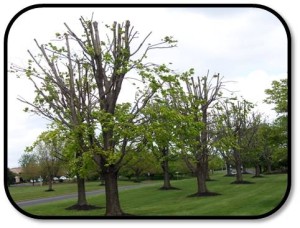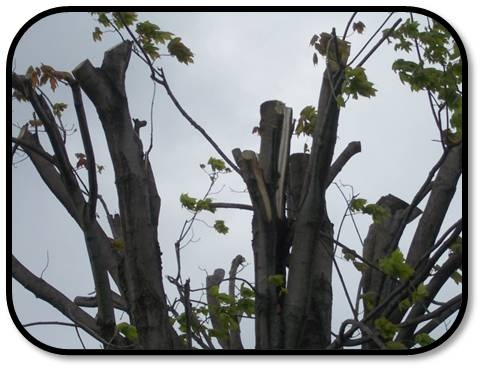 One of the worst things we can do to harm the long-term health of our landscape trees is to top them. When trees grow too large for their site, topping is sometimes used as a relatively quick and less-expensive method of size reduction. The truth is, topping is an extremely destructive pruning method that involves the removal of 50 – 100% of the leaf-bearing canopy. This places the tree under severe chronic stress. In a effort to rapidly produce new leaf material for photosynthesis, topping induces a cascade of physiological processes that force the tree to use up valuable and often limited stored energy reserves to begin rapid shoot growth and refoliation. The numerous wounds inflicted by topping are difficult to compartmentalize and seal-over, exposing branches to fungal decay diseases and insect pests.
One of the worst things we can do to harm the long-term health of our landscape trees is to top them. When trees grow too large for their site, topping is sometimes used as a relatively quick and less-expensive method of size reduction. The truth is, topping is an extremely destructive pruning method that involves the removal of 50 – 100% of the leaf-bearing canopy. This places the tree under severe chronic stress. In a effort to rapidly produce new leaf material for photosynthesis, topping induces a cascade of physiological processes that force the tree to use up valuable and often limited stored energy reserves to begin rapid shoot growth and refoliation. The numerous wounds inflicted by topping are difficult to compartmentalize and seal-over, exposing branches to fungal decay diseases and insect pests.
Ironically, many trees are topped in a effort to reduce their size and risk. However, below topping cuts, we often see a profusion of rapidly growing but weakly attached shoots that actually increase the risk of future branch failure. These weakly attached branches represent an even greater risk of breaking during storms or snow and ice events. If it survives, within just a few years, a topped tree will be as tall as before being topped, requiring additional pruning costs. Also, topping irreversibly destroys the original, natural form of the tree.
 If your trees need pruning, please contact an ISA-certified arborist for professional advice on alternatives to topping.
If your trees need pruning, please contact an ISA-certified arborist for professional advice on alternatives to topping.
For more information on topping and why you should hire a certified arborist, please download the following brochures:
- Remember: It is strictly prohibited to top a street tree or a tree in a planting easement in Hanover Township
- It is important to select tree varieties that will be the appropriate size at maturity for the site so that extreme measures like topping are not necessary.
